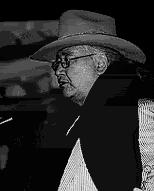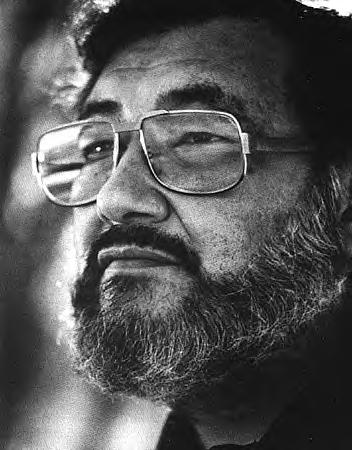|
 N. Scott
Momaday has always understood who he is. "I am an Indian and I believe I'm fortunate to have the heritage
I have," he says, speaking as a Kiowa Indian who defines himself as a Western Man. But that sense of identity
didn't evolve without difficulty. "I grew up in two worlds and straddle both those worlds even now,"
Momaday says. "It has made for confusion and a richness in my life. I've been able to deal with it reasonably
well, I think, and I value it." N. Scott
Momaday has always understood who he is. "I am an Indian and I believe I'm fortunate to have the heritage
I have," he says, speaking as a Kiowa Indian who defines himself as a Western Man. But that sense of identity
didn't evolve without difficulty. "I grew up in two worlds and straddle both those worlds even now,"
Momaday says. "It has made for confusion and a richness in my life. I've been able to deal with it reasonably
well, I think, and I value it."
Navarre Scott Momaday was born in Lawton, Oklahoma and spent the first year of his life at his grandparents' home
on the Kiowa Indian reservation, where his father was born and raised. When he was one year old, Scott's parents
moved to Arizona. His father was a painter. His mother, who is of English and Cherokee descent, became an author
of children's books. Both worked as teachers on Indian reservations when Scott was growing up, and the boy was
exposed not only to the Kiowa traditions of his father's family but to the Navajo, Apache and Pueblo Indian cultures
of the Southwest. Momaday early developed an interest in literature, especially poetry.
Momaday was born in 1934 and spent his childhood on the Navajo, Apache and Pueblo reservations of the southwest.
"I had a Pan-Indian experience as a child, even before I knew what that term meant," he recalls. Eventually,
after enduring the job-scarce rigors of the Depression, the family settled in New Mexico, where Momaday's parents,
both teachers, taught for 25 years in a two-teacher Indian day school. Momaday's father was also a painter and
his mother a writer. "I grew up in a creative household and followed in my mother's footsteps, to begin with,"
says Momaday, who later became a painter, as well, and has extensively exhibited his work here and abroad. "I
was interested in reading and writing early on."
Those literary interests led to a lifelong love affair with American and English literature. After getting his
BA at the University of New Mexico, Momaday earned an MA and Ph.D at Stanford University. During the 35+ years
of his academic career, Momaday's reputation as a scholar who specializes in the work of Emily Dickinson and Frederick
Goddard Tuckerman, as well as in Indian oral tradition and concepts of the sacred, has resulted in his receiving
numerous awards. These include a Guggenheim Fellowship, a National Institute of Arts and Letters Award, and the
Premio Letterario Internationale Mondello, Italy's highest literary award. Momaday has also had tenured appointments
at the Santa Barbara and Berkeley campuses of the University of California, Stanford University and the University
of Arizona. He developed his first course in Indian oral tradition in 1969 while he was at Berkeley and "I've
been teaching it every year since." In addition, Momaday has been a visiting professor at Columbia and Princeton;
was the first professor to teach American literature at the University of Moscow in Russia and holds 12 honorary
degrees from various American universities, including Yale.
Momaday is the author of 13 books, including novels, poetry collections, literary criticism, and works on Native
American culture. His first novel, House Made of Dawn, won the Pulitzer Prize, but his favorites are The Ancient
Child, his most recent novel, because "it is a greater act of the imagination," and, The Way to Rainy
Mountain because "it presents a good, accurate picture of Kiowa culture in its heyday."
 N. Scott Momaday's writing says more about him and the land and people he writes about than any
description of him can convey. The following is from his Pulitzer Prize-winning novel House Made of Dawn, written
in 1966. The story is about Abel, a young Indian torn between the two worlds he lives in. But in this excerpt,
the speaker is Tosamah, an Indian orator and physician. N. Scott Momaday's writing says more about him and the land and people he writes about than any
description of him can convey. The following is from his Pulitzer Prize-winning novel House Made of Dawn, written
in 1966. The story is about Abel, a young Indian torn between the two worlds he lives in. But in this excerpt,
the speaker is Tosamah, an Indian orator and physician.
"The Kiowas are a summer people; they abide the cold and keep to themselves, but when the season turns and
the land becomes warm and vital they cannot hold still; an old love of going returns upon them. The old people
have a fine sense of pageantry and a wonderful notion of decorum. The aged visitors who came to my grandmother's
house when I was a child were men of immense character, full of wisdom and disdain. They dealt in a kind of infallible
quiet and gave but one face away; it was enough. They were made of lean and leather, and they bore themselves upright.
They wore great black hats and bright ample shirts that shook in the wind. They rubbed fat upon their hair and
wound their braids with strips of colored cloth. Some of them painted their faces and carried the scars of old
and cherished enmities. They were an old council of war lords, come to remind and be reminded of who they were...
"There were frequent prayer meetings, and great nocturnal feasts. When I was a child, I played with my cousins
outside, where the lamplight fell upon the ground and the singing of the old people rose up around us and carried
away into the darkness. There were a lot of good things to eat, a lot of laughter and surprise. And afterward,
when the quiet returned, I lay down with my grandmother and could hear the frogs away by the river and feel the
motion of the air.
"Now there is a funeral silence in the rooms, the endless wake of some final word. The walls have closed in
upon my grandmother's house. When I returned to it in mourning, I saw for the first time in my life how small it
was. It was late at night, and there was a white moon, nearly full. I sat for a long time on the stone steps by
the kitchen door. From there I could see out across the land; I could see the long row of trees by the creek, the
low light upon the rolling plains, and the stars of the Big Dipper. Once I looked at the moon and caught sight
of a strange thing. A cricket had perched upon the handrail, only a few inches away from me. My line of vision
was such that the creature filled the moon like a fossil. It had gone there, I thought, to live and die, for there
of all places was its small definition made whole and eternal. A warm wind rose up and purled like the longing
within me...."
- N.Scott Momaday
- http://www.yvwiiusdinvnohii.net/Bookstore/Momaday.htm
|
 N. Scott
Momaday has always understood who he is. "I am an Indian and I believe I'm fortunate to have the heritage
I have," he says, speaking as a Kiowa Indian who defines himself as a Western Man. But that sense of identity
didn't evolve without difficulty. "I grew up in two worlds and straddle both those worlds even now,"
Momaday says. "It has made for confusion and a richness in my life. I've been able to deal with it reasonably
well, I think, and I value it."
N. Scott
Momaday has always understood who he is. "I am an Indian and I believe I'm fortunate to have the heritage
I have," he says, speaking as a Kiowa Indian who defines himself as a Western Man. But that sense of identity
didn't evolve without difficulty. "I grew up in two worlds and straddle both those worlds even now,"
Momaday says. "It has made for confusion and a richness in my life. I've been able to deal with it reasonably
well, I think, and I value it." N. Scott Momaday's writing says more about him and the land and people he writes about than any
description of him can convey. The following is from his Pulitzer Prize-winning novel House Made of Dawn, written
in 1966. The story is about Abel, a young Indian torn between the two worlds he lives in. But in this excerpt,
the speaker is Tosamah, an Indian orator and physician.
N. Scott Momaday's writing says more about him and the land and people he writes about than any
description of him can convey. The following is from his Pulitzer Prize-winning novel House Made of Dawn, written
in 1966. The story is about Abel, a young Indian torn between the two worlds he lives in. But in this excerpt,
the speaker is Tosamah, an Indian orator and physician.